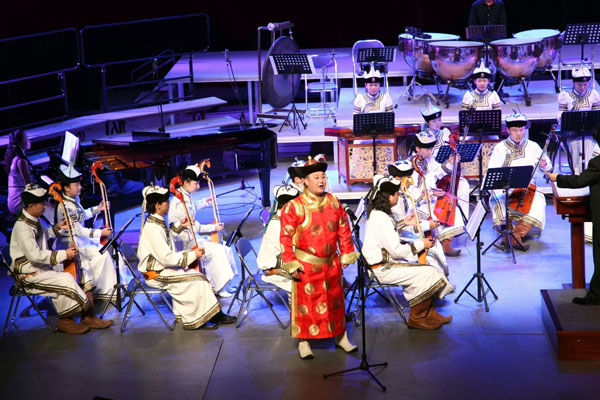Tracing the artistic traditions of Mongolian Khoomei in China

A Mongolian artist performs a traditional throat-singing Tuva Khoomei.
On Sept. 30, 2009, UNESCO added the art of Chinese Mongolian Khoomei singing to the Representative List of the Intangible Cultural Heritage of Humanity. Khoomei, the superb art of throat-singing, has spread throughout Chinese Inner Mongolia, Xinjiang area, Mongolia and seven republics of the Russian Federation known as the circle of Mongolian Culture, including Tuva, Tatar, Khakass, Bashkir, Kalmykia, Buryatia and Yakutia.
Khoomei is one of the oldest historical forms of vocal music, which is why studies on Mongolian Khoomei is vital to the search for the origin of the Mongolian nationality and establishing a time frame for Mongolian prehistory. Between May and July 2012, when a team from the Institute of Archaeology at the Chinese Academy of Social Sciences surveyed and mapped the site of Xinglonggou in Inner Mongolia, they excavated and repaired a pottery statue made in the later period of Hongshan culture more than 5,300 years ago.
The first piece of prehistoric pottery statue discovered in China, scholars disputed “the pottery statue’s placement and functions, its identity and the meaning of its mouth movement.” On the basis of historical materials and the understanding of artistic traditions of the Mongolian nationality’s music, I think the pottery statue’s mouth movement depicts a figure exerting strength to sing loudly and in particular to perform Khoomei singing. This pottery statue can be said to be a representative of the “originator of Khoomei art” based on its long history.
In fact, Khoomei has long been popular on the Mongolian Plateau within today’s Chinese territory. As early as the Spring and Autumn Period, the Chronicle of Zuo recorded Khoomei singing.
During the medieval period, Tiele people, an ancient nationality in North China, lived a nomadic lifestyle on the Mongolian Plateau. Because they preferred to ride high-sided wagons, they were called people of high-sided wagons. The famous The Ode to the Tiele is a beautiful pastoral for the prairie created by people of high-sided wagons. The singing methods applied by people of high-sided wagons have combined traditions of Mongolian long tune and Mongolian Khoomei. The emergence and development of long tune and Khoomei are related to the worship and simulation of the wolf totem by people of the prairie.
At the beginning of the Qing Dynasty, Mongolian Khoomei began to popularize in the south. In the reign of Emperor Qianlong, the court established a specialized agency for managing Mongolian music known as the “Shibang Division.” Written in the late Qing Dynasty, Liu E’s vivid description of Mongolian Khoomei in The Travels of Lao Can attempted to capture its essence for posterity.
Fan Ziye is from the Institute of Literature at the Chinese Academy of Social Sciences.
The Chinese version appeared in Chinese Social Sciences Today, No. 636, August 20, 2014
Translated by Zhang Mengying
The Chinese link:
http://sscp.cssn.cn/xkpd/ysx_20173/201408/t20140820_1298070.html
